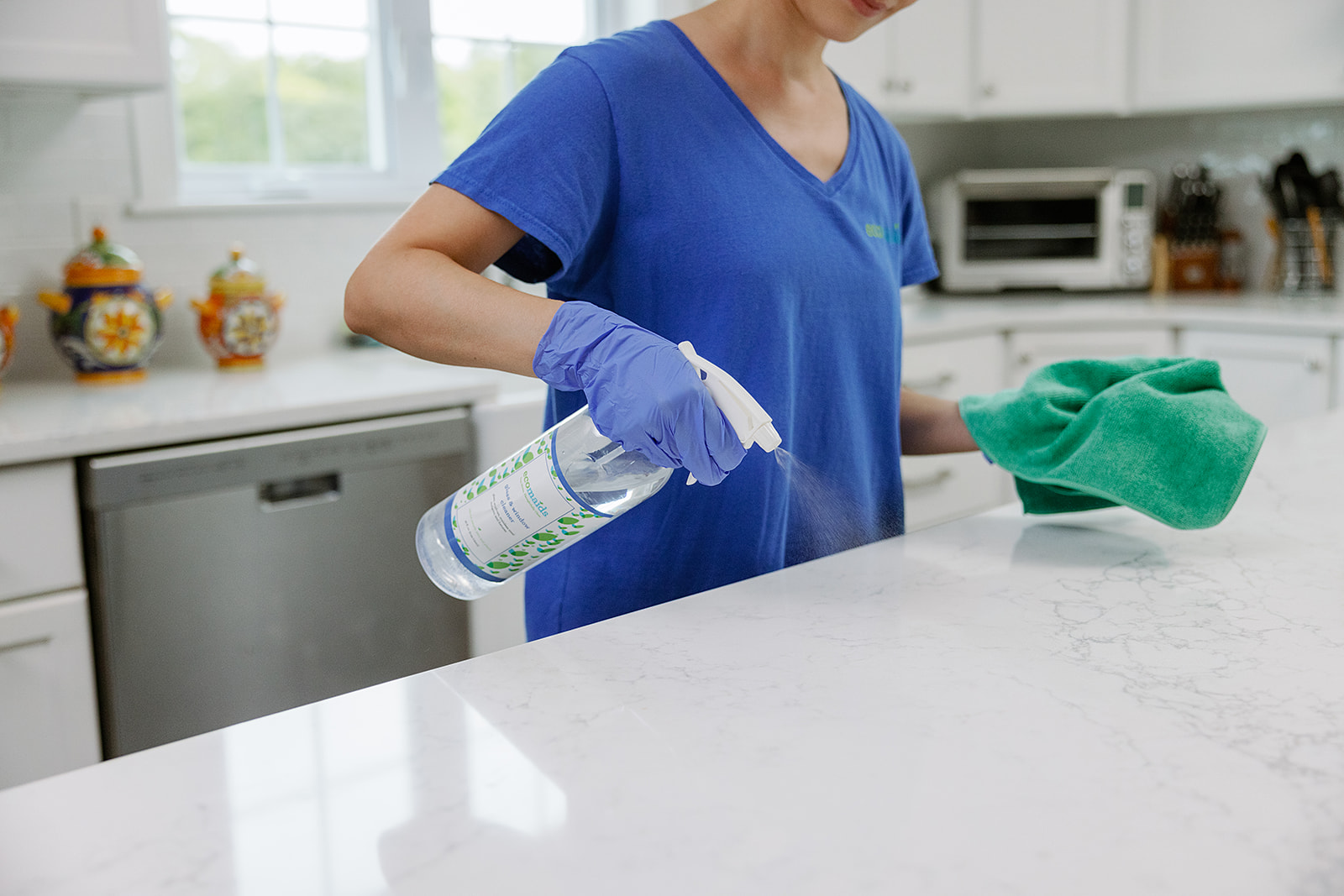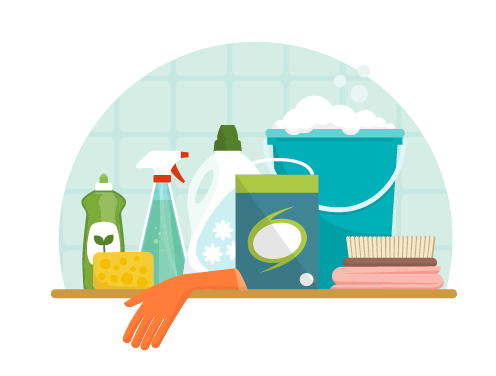Comprehending the Requirement for Thoroughly Disinfecting and Sanitizing Frequently Touched Surface Areas in High-Traffic Locations
In the realm of public health and wellness and safety, the thorough disinfection and sanitization of often touched surfaces in high-traffic locations stand as paramount steps in avoiding the spread of unsafe microorganisms. By discovering the various facets of surface sanitation, from the dangers associated with disregarding cleaning methods to the reliable methods that can be employed, a clearer understanding emerges of the essential duty these techniques play in securing public wellness.
Relevance of Surface Area Disinfection
Highlighting the complete sanitation of high-traffic surface areas is critical in keeping a sanitary setting and stopping the spread of dangerous microorganisms. High-touch surface areas such as door takes care of, light buttons, elevator buttons, and counter tops function as breeding premises for infections and microorganisms. Routine disinfection of these surfaces is essential to decrease the danger of contamination and transmission of ailments.
By applying a robust sanitation protocol, services and establishments can produce a more secure atmosphere for visitors, customers, and staff members. Appropriate surface sanitation not only reduces the spread of infectious conditions however additionally infuses self-confidence in the sanitation and security of the properties. This aggressive method demonstrates a dedication to wellness and health, which is particularly crucial in high-traffic areas where the chance of direct exposure to microorganisms is heightened.
In addition, surface sanitation plays a critical duty in general infection control techniques. Combined with hand hygiene techniques, using masks, and keeping physical distancing, complete disinfection of high-touch surfaces creates a comprehensive protection against the transmission of harmful microbes. Focusing on surface disinfection is a crucial component of an alternative strategy to health and wellness and safety and security in shared areas.
Threats of Overlooking Cleansing Practices
Neglecting complete sanitation of high-traffic surface areas substantially enhances the risk of bacterial and viral contamination, positioning a major threat to the wellness and safety of individuals frequenting these spaces. Failure to execute correct cleaning methods can result in the build-up and spread of unsafe microorganisms, including germs and infections, on regularly touched surface areas such as doorknobs, hand rails, lift switches, and counter tops.

Additionally, disregarding the value of extensive cleansing not only jeopardizes the well-being of people but also weakens efforts to maintain a hygienic and tidy atmosphere. It is crucial to acknowledge the relevance of correct sanitation protocols in stopping the spread of infections and securing public wellness.
Efficient Disinfection Methods
To keep ideal tidiness and reduce the risk of contamination on high-traffic surfaces, using reliable sanitation methods is essential. One of the most common and efficient disinfection methods is utilizing chemical anti-bacterials.
One more efficient method is using UV-C light. UV-C light has been revealed to be efficient in eliminating a wide array of microorganisms by interrupting their DNA structure, thus preventing them from duplicating. It is important to use UV-C light properly, guaranteeing that the right intensity and direct exposure time are applied to attain the desired disinfection outcomes.
In addition, employing heavy steam cleansing as a sanitation approach can be highly reliable, especially on surfaces that are heat-resistant. Vapor can pass through porous surfaces and kill microorganisms, infections, and various other virus properly. When using steam cleaning, it is necessary to make sure read here that the surface reaches the required temperature for a sufficient quantity of time to ensure correct sanitation.
Effect on Public Health And Wellness
The maintenance of high standards of sanitation and disinfection on high-traffic surfaces plays a vital duty in safeguarding public wellness. Often touched surface areas in areas with high footfall, such as doorknobs, hand rails, lift buttons, and restroom centers, act as breeding premises for dangerous virus. Stopping working to appropriately sanitize these surfaces can bring about the rapid spread of transmittable illness within communities. By implementing complete disinfection protocols, the danger of transmission of viruses, microorganisms, and other bacteria can be considerably lowered.
Efficient hygiene techniques not just protect individuals from dropping ill but likewise add to the overall wellness of culture. Public health authorities highlight the importance of preserving tidy settings to stop break outs and consist of the spread of diseases. In high-traffic locations like airport terminals, institutions, medical facilities, and mass transit systems, the effect of strenuous disinfection procedures can not be underrated. Prioritizing the sanitization of frequently touched surface areas is a proactive method to advertising public wellness and boosting the safety and security of people in common spaces.
Applying Routine Cleaning Protocols
Promptly setting up and sticking to a constant schedule of cleaning methods is paramount for keeping the cleanliness and safety of high-traffic surfaces. Regular cleansing methods are important in avoiding the build-up of bacteria and microorganisms on often touched surfaces, particularly in areas with high foot website traffic. By executing a systematic approach to cleansing, organizations can effectively decrease the threat of illness transmission and create a much healthier setting for staff members, clients, and the general public.
To establish a reliable cleaning schedule, it is crucial to determine high-traffic areas that call for constant interest. These locations may consist of doorknobs, handrails, lift buttons, toilet facilities, and common equipment. Carrying out a routine cleansing routine that targets these surfaces multiple times a day can substantially minimize the spread of hazardous microorganisms and viruses.
Additionally, utilizing suitable cleaner and disinfectants is essential to ensuring that surfaces are thoroughly sanitized. Regular training of cleansing team on proper cleansing methods and Recommended Site the importance of adherence to the cleansing schedule is also crucial in maintaining a hygienic atmosphere. By focusing on regular cleansing methods, organizations can promote the health and health of people that connect with these high-traffic surface areas.

Conclusion
In final thought, it is crucial to focus on comprehensive disinfection and sanitization of regularly touched surfaces in high-traffic locations to avoid the spread of unsafe pathogens and preserve public health and wellness. It is crucial to recognize the significance of keeping tidy surfaces in high-traffic areas to make sure the well-being of the area.
In the Check This Out world of public wellness and security, the meticulous disinfection and sanitization of regularly touched surface areas in high-traffic areas stand as critical measures in protecting against the spread of dangerous microorganisms. By checking out the numerous aspects of surface area disinfection, from the threats associated with ignoring cleansing methods to the reliable techniques that can be used, a more clear understanding arises of the essential duty these techniques play in protecting public wellness.Furthermore, using heavy steam cleansing as a sanitation method can be highly effective, especially on surface areas that are heat-resistant. When utilizing heavy steam cleaning, it is important to make sure that the surface area gets to the called for temperature level for an enough amount of time to assure correct sanitation.
In conclusion, it is vital to prioritize extensive sanitation and sanitization of frequently touched surfaces in high-traffic locations to protect against the spread of hazardous pathogens and keep public health and wellness.